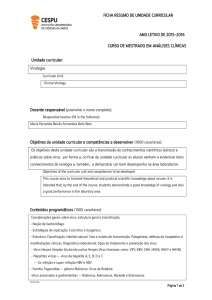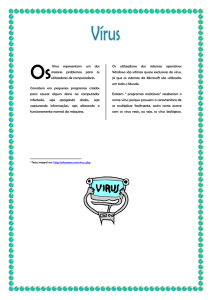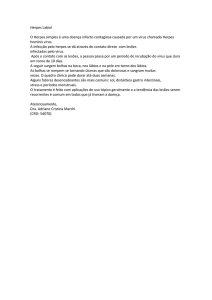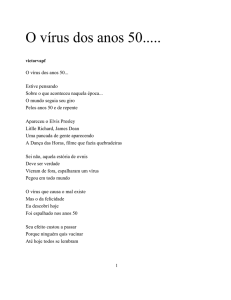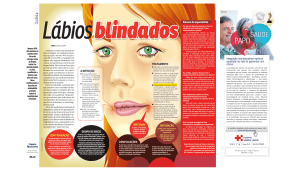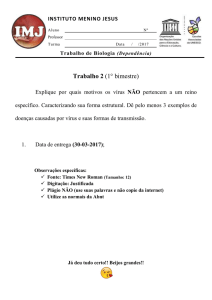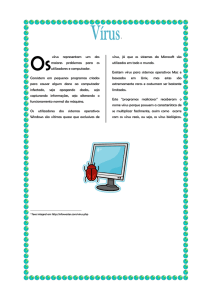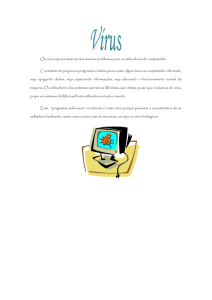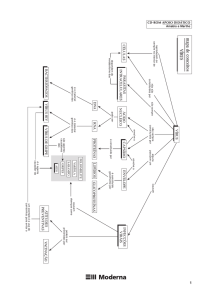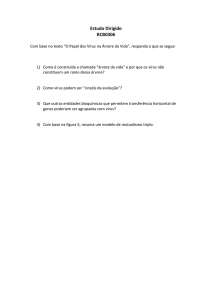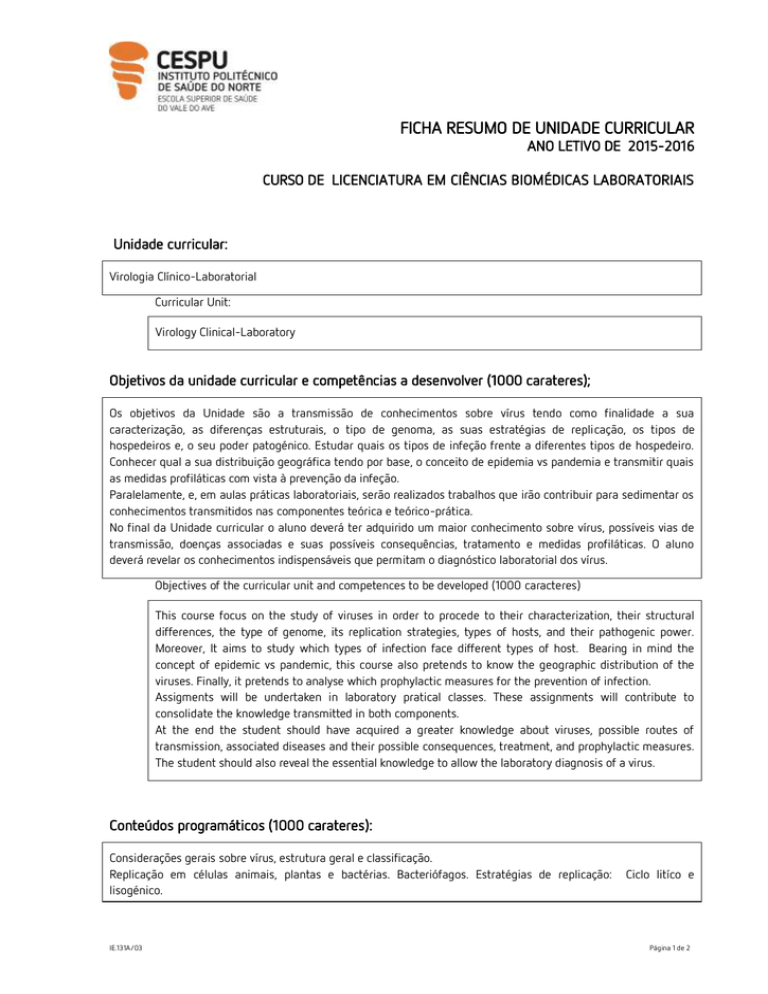
FICHA RESUMO DE UNIDADE CURRICULAR
ANO LETIVO DE 2015-2016
CURSO DE LICENCIATURA EM CIÊNCIAS BIOMÉDICAS LABORATORIAIS
Unidade curricular:
Virologia Clínico-Laboratorial
Curricular Unit:
Virology Clinical-Laboratory
Objetivos da unidade curricular e competências a desenvolver (1000 carateres);
Os objetivos da Unidade são a transmissão de conhecimentos sobre vírus tendo como finalidade a sua
caracterização, as diferenças estruturais, o tipo de genoma, as suas estratégias de replicação, os tipos de
hospedeiros e, o seu poder patogénico. Estudar quais os tipos de infeção frente a diferentes tipos de hospedeiro.
Conhecer qual a sua distribuição geográfica tendo por base, o conceito de epidemia vs pandemia e transmitir quais
as medidas profiláticas com vista à prevenção da infeção.
Paralelamente, e, em aulas práticas laboratoriais, serão realizados trabalhos que irão contribuir para sedimentar os
conhecimentos transmitidos nas componentes teórica e teórico-prática.
No final da Unidade curricular o aluno deverá ter adquirido um maior conhecimento sobre vírus, possíveis vias de
transmissão, doenças associadas e suas possíveis consequências, tratamento e medidas profiláticas. O aluno
deverá revelar os conhecimentos indispensáveis que permitam o diagnóstico laboratorial dos vírus.
Objectives of the curricular unit and competences to be developed (1000 caracteres)
This course focus on the study of viruses in order to procede to their characterization, their structural
differences, the type of genome, its replication strategies, types of hosts, and their pathogenic power.
Moreover, It aims to study which types of infection face different types of host. Bearing in mind the
concept of epidemic vs pandemic, this course also pretends to know the geographic distribution of the
viruses. Finally, it pretends to analyse which prophylactic measures for the prevention of infection.
Assigments will be undertaken in laboratory pratical classes. These assignments will contribute to
consolidate the knowledge transmitted in both components.
At the end the student should have acquired a greater knowledge about viruses, possible routes of
transmission, associated diseases and their possible consequences, treatment, and prophylactic measures.
The student should also reveal the essential knowledge to allow the laboratory diagnosis of a virus.
Conteúdos programáticos (1000 carateres):
Considerações gerais sobre vírus, estrutura geral e classificação.
Replicação em células animais, plantas e bactérias. Bacteriófagos. Estratégias de replicação:
lisogénico.
IE.131A/03
Ciclo litíco e
Página 1 de 2
Estrutura, classificação, habitat natural, patogénese, defesas do hospedeiro, manifestações clínicas, diagnóstico
laboratorial, tratamento e prevenção das seguintes viroses:
- Vírus Herpes Simplex (incluindo outros Herpes Vírus Humanos como: VZV; EBV; CMV; HHV6; HHV7 e HHV8)
- Vírus associados a gastrenterites – Rotavírus, Adenovírus, Enterovírus; Norwalk
- Família Togaviridae – género Alphavirus e género Rubivirus;
- Família Retroviridae – HTLV 1 e 2, HIV 1 e 2;
- Infeções respiratórias víricas – Rhinovirus, Orthomyxoviridae, Paramyxoviridae (género
Morbillivirus,
Paramyxovirus, Pneumovirus – VSR, e género Rubulavirus – vírus da parotidite);
- Hepatites víricas – vírus da hepatite A, B; C; D e E
- Papovavirus
- Família Filoviridae
- Família Parvoviridae
Syllabus (1000 caracteres)
General considerations about viruses, general structure and classification.
Replication in animal cells, plants and bacteria. Bacteriophages. Strategies of replication: lytic cycle and
lysogenic.- Structure, classification, natural habitat, pathogenesis, host defenses, clinical manifestations,
laboratory diagnosis, treatment and prevention of the following viruses:
- Herpes Simplex Virus (including other human herpes virus such as VZV, EBV, CMV, HHV6, and HHV8
HHV7)
- Viruses associated with gastroenteritis - rotavirus, adenovirus, enterovirus, Norwalk
- Family Togaviridae - gender Rubivirus and Alphavirus;
- Family Retroviridae - HTLV 1 and 2, HIV 1 and 2;
- Viral respiratory infections - Rhinovirus, Orthomyxoviridae, Paramyxoviridae (gender Morbillivirus,
paramyxovirus, pneumovirus - RSV, and gender Rubulavirus - Mumps virus);
- Viral hepatitis - hepatitis A, B, C, D and E
- Papovavirus
- Family Filoviridae
- Family Parvoviridae
Referências bibliográficas (máximo três títulos):
1. Ferreira W, Sousa J: Microbiologia - volume III. Lisboa: Lidel – Edições Técnicas, lda. 2000
2. Ferreira A, Ávila S: Diagnóstico Laboratorial das principais doenças infecciosas e auto-imunes. Rio de Janeiro:
Guanabara Koogan S. A. 2001
3. Jawetz E, Melnick J, Adelberg E: Microbiologia Médica - 24 Edição. McGraw-Hill Brasil-Saude. 2008
IE.131A/03
Página 2 de 2

